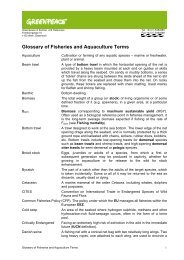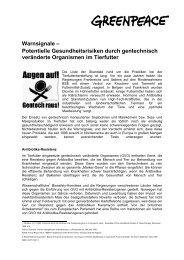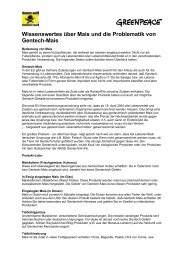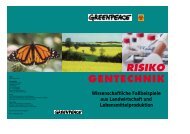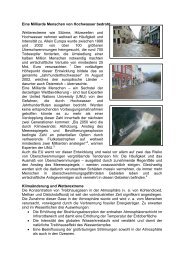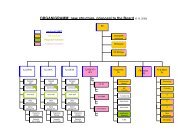POISON UNDERFOOT Hazardous Chemicals in PVC Flooring and ...
POISON UNDERFOOT Hazardous Chemicals in PVC Flooring and ...
POISON UNDERFOOT Hazardous Chemicals in PVC Flooring and ...
You also want an ePaper? Increase the reach of your titles
YUMPU automatically turns print PDFs into web optimized ePapers that Google loves.
they have a larger volume of respiration than adults per kilo bodyweight. The health of young<br />
children is of particular concern with regard to phthalates <strong>in</strong> <strong>PVC</strong> floors. A study <strong>in</strong> Norway<br />
found that children liv<strong>in</strong>g <strong>in</strong> homes with <strong>PVC</strong> floors had a higher <strong>in</strong>cidence of bronchial<br />
obstruction than children liv<strong>in</strong>g <strong>in</strong> homes with wooden floors It was suggested that this may<br />
have been due to exposure to plasticisers <strong>in</strong> the <strong>PVC</strong>.<br />
Three of the eight carpet samples were found to conta<strong>in</strong> significant levels of permethr<strong>in</strong> (up to<br />
78 ppb), a pesticide used aga<strong>in</strong>st dust mites. Permethr<strong>in</strong> has been reported to have effects on the<br />
nervous system (neurotoxic) <strong>in</strong> laboratory animals. Previous research <strong>in</strong> Germany has<br />
demonstrated that elevated concentrations of permethr<strong>in</strong> found <strong>in</strong> domestic homes were largely<br />
due to the presence of treated carpets. The presence of permethr<strong>in</strong> <strong>in</strong> carpets analysed <strong>in</strong> the<br />
present study is of concern given the potential human exposure <strong>in</strong> the home via its migration to<br />
air <strong>and</strong> dusts. It is of note that a previous study reported that typical permethr<strong>in</strong> treatment of<br />
carpets, where permethr<strong>in</strong> penetrates the carpet fibres, was not effective <strong>in</strong> prevent<strong>in</strong>g habitation<br />
by dust mites.<br />
One of the eight carpet samples conta<strong>in</strong>ed significant levels (1600 ppb) of<br />
2,2’,3,3’,4,4’,5,5’,6,6’-decabromodiphenyl ether (BDE-209), a brom<strong>in</strong>ated flame retardant<br />
chemical. This is of concern given the persistent <strong>and</strong> toxic nature of this compound. While fire<br />
safety is an issue which cannot be compromised, it can be achieved through the use other less<br />
hazardous fire retardants or through redesign <strong>and</strong>/or reformulation of materials to achieve lower<br />
flammability. Five of the carpet samples were also found to conta<strong>in</strong> formaldehyde at low ppm<br />
concentrations.<br />
In conclusion, several hazardous chemicals were found <strong>in</strong> significant concentrations <strong>in</strong> new<br />
<strong>PVC</strong> floor<strong>in</strong>g <strong>and</strong> carpets. This highlights the cont<strong>in</strong>ued widespread use of hazardous chemicals<br />
<strong>in</strong> consumer products, uses for which most of the public will be unaware. The presence <strong>and</strong> the<br />
high concentrations of some of the chemicals <strong>in</strong> <strong>PVC</strong> floors <strong>and</strong> carpets was unexpected given<br />
that they are recognised as hazardous chemicals at both national <strong>and</strong> <strong>in</strong>ternational levels <strong>and</strong>, <strong>in</strong><br />
some cases, plans exist to reduce their use or phase them out.<br />
The results of this study are of concern as the presence of hazardous chemicals <strong>in</strong> <strong>PVC</strong> floor<strong>in</strong>g<br />
<strong>and</strong> carpets <strong>in</strong>evitably leads to human exposure <strong>in</strong> the <strong>in</strong>door environment. Floor<strong>in</strong>g makes up a<br />
substantial surface area with<strong>in</strong> the home; <strong>in</strong> particular, young children who breathe <strong>and</strong> play<br />
close to the floor are more likely to be exposed to hazardous chemicals <strong>in</strong> both <strong>PVC</strong> floor<strong>in</strong>g<br />
<strong>and</strong> fitted carpet. Although the consequences of long-term exposure to these chemicals <strong>in</strong> the<br />
<strong>in</strong>door environment is uncerta<strong>in</strong>, the chemicals have properties which make them potentially<br />
hazardous to human health <strong>and</strong> the environment. The identification of hazardous chemicals <strong>in</strong><br />
<strong>PVC</strong> floor<strong>in</strong>g <strong>and</strong> carpets by this study has revealed an important product sector which will<br />
need attention to prevent human exposure to such chemicals <strong>and</strong> possible health consequences.<br />
The data for the above study has been published as two <strong>in</strong>dividual technical notes, one on <strong>PVC</strong><br />
floor<strong>in</strong>g <strong>and</strong> the other on carpets. The former has already been submitted to the European<br />
Commission’s public consultation on Environmental Issues of <strong>PVC</strong>, <strong>in</strong> November 2000.<br />
3


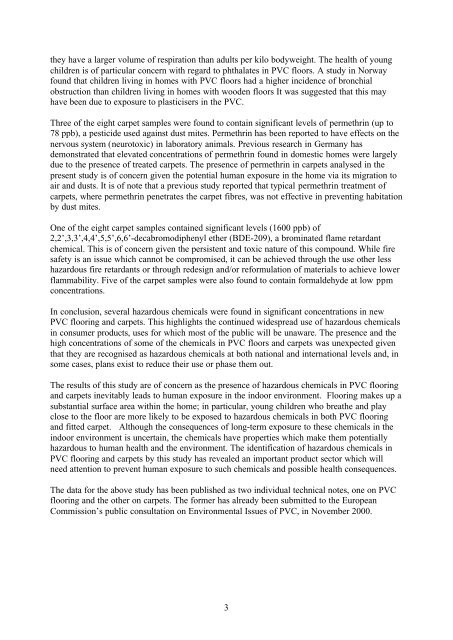
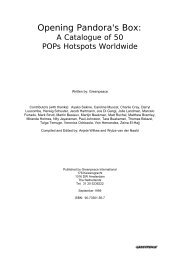
![3. Die Energie-[R]evolution](https://img.yumpu.com/22078498/1/184x260/3-die-energie-revolution.jpg?quality=85)

